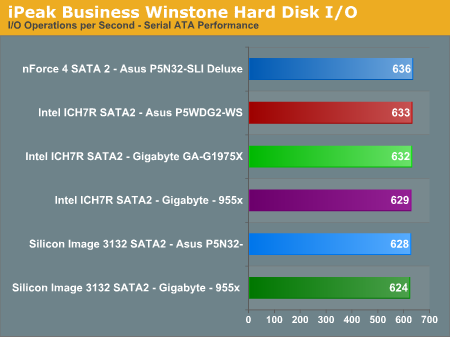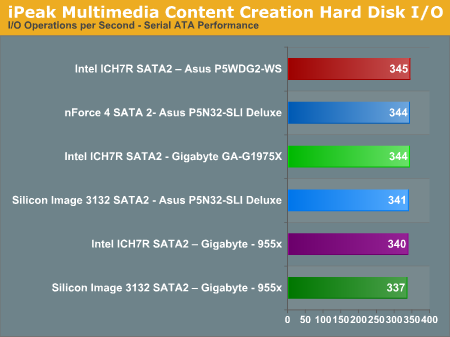Asus P5WDG2-WS: Intel 975X goes to Work
by Gary Key on December 6, 2005 12:05 AM EST- Posted in
- Motherboards
Disk Controller Performance
With the variety of disk drive benchmarks available, we needed a means of comparing the true performance of the wide selection of controllers. The logical choice was Anand's storage benchmark first described in Q2 2004 Desktop Hard Drive Comparison: WD Raptor vs. the World. The iPeak test was designed to measure "pure" hard disk performance, and in this case, we kept the hard drive as consistent as possible while varying the hard drive controller. The idea is to measure the performance of a hard drive controller with a consistent hard drive.
We played back Anand's raw files that recorded I/O operations when running a real world benchmark - the entire Winstone 2004 suite. Intel's iPEAK utility was then used to play back the trace file of all IO operations that took place during a single run of Business Winstone 2004 and MCC Winstone 2004. To try to isolate performance differences to the controllers that we were testing, we used the Maxtor MaXLine III 7L300S0 300GB 7200 RPM SATA drive in all tests . The drive was formatted before each test run and a composite average of 5 tests on each controller interface was tabulated in order to ensure consistency in the benchmark.
iPeak gives a mean service time in milliseconds; in other words, the average time that each drive took to fulfill each IO operation. In order to make the data more understandable, we report the scores as an average number of IO operations per second so that higher scores translate into better performance. This number is meaningless as far as hard disk performance is concerned as it is just the number of IO operations completed in a second. However, the scores are useful for comparing "pure" performance of the storage controllers in this case.
With the variety of disk drive benchmarks available, we needed a means of comparing the true performance of the wide selection of controllers. The logical choice was Anand's storage benchmark first described in Q2 2004 Desktop Hard Drive Comparison: WD Raptor vs. the World. The iPeak test was designed to measure "pure" hard disk performance, and in this case, we kept the hard drive as consistent as possible while varying the hard drive controller. The idea is to measure the performance of a hard drive controller with a consistent hard drive.
We played back Anand's raw files that recorded I/O operations when running a real world benchmark - the entire Winstone 2004 suite. Intel's iPEAK utility was then used to play back the trace file of all IO operations that took place during a single run of Business Winstone 2004 and MCC Winstone 2004. To try to isolate performance differences to the controllers that we were testing, we used the Maxtor MaXLine III 7L300S0 300GB 7200 RPM SATA drive in all tests . The drive was formatted before each test run and a composite average of 5 tests on each controller interface was tabulated in order to ensure consistency in the benchmark.
iPeak gives a mean service time in milliseconds; in other words, the average time that each drive took to fulfill each IO operation. In order to make the data more understandable, we report the scores as an average number of IO operations per second so that higher scores translate into better performance. This number is meaningless as far as hard disk performance is concerned as it is just the number of IO operations completed in a second. However, the scores are useful for comparing "pure" performance of the storage controllers in this case.












31 Comments
View All Comments
Cygni - Wednesday, December 7, 2005 - link
Workstation /= server...Overclocking isnt wacky in the worstation world at all. Picture a guy using 3dsmax everyday in his personal studio, or rendering TV streams in Maya, or doing texture work, or compiling source codes at a game studio...
Overclocking in the Workstation market is probably ALOT more common than people would think. Take overclocking that Pressler. That big of an overclock could mean whole DAYS of extra time per year that the CPU would have otherwise been spending cranking away on rendering. Thats a serious gain.
I dont think many serious servers will find a board like this one in em, to boot. Its lacking alot of features that a serious server hosting lots of users would deffinitly feel the need for... like built in SCSI, multi cpu support, RAM support over 8gig/4slot, etc.
On the other hand, this is a near perfect workstation board. High clocked RAM support for both ECC and non ECC. Non buffered memory. Both SLI and Crossfire support at 8x/8x. Plenty of SATA II plugs for cheap storage.
I took notice of the OC results and settings, and i like what i saw. :)
Cygni - Wednesday, December 7, 2005 - link
That was a reply to the poster one level up, sorry. :DThanks for taking the time to do the OC tests, however. Some people out there did like to see em.
Zebo - Tuesday, December 6, 2005 - link
If those 4.8ghz air overclocks are normal intel won't have to wait for conroe to take back enthusiasts crown. That's amazing.Leper Messiah - Tuesday, December 6, 2005 - link
Hell yeah. 4.8GHz on air with Dual core is a 20% over what an 840EE will do. And I bet that with nF4 and a DFI 5.0+ is possible. oooh. Sexay.stephenbrooks - Tuesday, December 6, 2005 - link
Yeah, I'm wondering if the Pentium D 920 might become a new "favourite" chip for them to play with :)Niv KA - Tuesday, December 6, 2005 - link
Talking about Conroe, isn't the 975X supposed to support upgradability to itxtremejack - Tuesday, December 6, 2005 - link
If you look at the chipset price guides for this month by Anand, 975x will not support ConroeGary Key - Tuesday, December 6, 2005 - link
Intel has not officially confirmed either way on the 975X to Conroe path. We have heard both a positive and negative on this but from different sources. As soon as we have a clear path it will be posted.Niv KA - Tuesday, December 6, 2005 - link
That would mean I could buy a 975X based MB with a Celeron and buy a Conroe in the summer without having to buy a new motherbord and allCalin - Tuesday, December 6, 2005 - link
When the graphs shows both min framerate and max framerate, I suggest that ordering should be done by the min framerate instead of the max framerate. Only on F.E.A.R. Performance test on the 9th page the results will change, and only for the top two boards - however, I prefer to have good consistent high framerate in the worst cases than extremely high framerate in the best conditions.Thanks